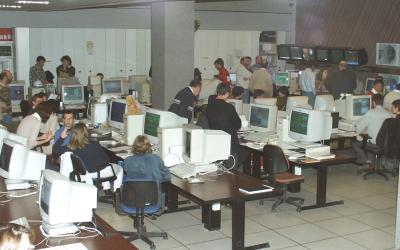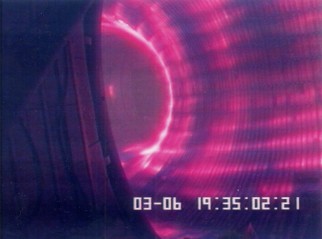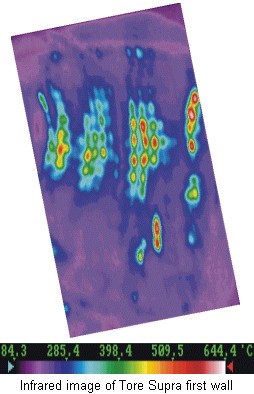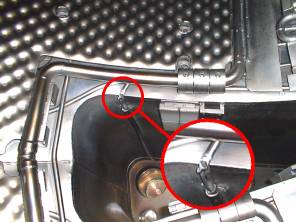|
8 - A common day in the life of Tore Supra
|
Beyond the purely scientific aspect, everyday life around Tore Supra is also a human adventure,
as in all great physics research tools. Come in and share a physicist everyday life with all its ups and downs |
Imagine that you are a physicist in the Department of Research on Controlled Fusion. Your specialist area is refining scenarios with the goal of achieving long pulses. Today you are the physicist in charge and it is up to you to decide what the day programme is on the Tore Supra tokamak. Your duty is to beat the record of energy injected into the machine, with long
well-performing discharges. The goal to be reached is to get to 300 MJ, with 4-5 MW of power
in a 60 to 70 seconds discharge (a little reminder: energy is equal to power multiplied by the time during which it is applied, so you have to manage to use a lot of MW on long durations).
 |
It is a risky programme, and the machine must be pushed to the limit. To help you, you have a whole team around you. First of all there is the pilot. He is the one at the controls of the machine, who carries out the programme that you carefully set out in advance. He is a key figure and like a sort of sea captain, he is the only master on board after God. Then there is the head of computing, whom you can rely on in the event of a system control or command problem or a problem of data acquisition. And, of course, everything is computerised on Tore Supra (or nearly everything), which is crucial to success. Then come all the people in charge of diagnostics and other sub-systems that you need for your day to go well. And finally there are the other physicists interested in the day’s schedule, each
with his or her own speciality. Quite a few people around in the control room, what do you think? |
| It is 8 o’clock, and the day is off to a start. The vacuum chamber has been conditioned by a series of glow
discharge during the night so that the wall is well de-saturated. The heavy doors have been closed on the tore hall, and the toroidal field is on. After a short briefing with the day team to make sure everything is ready, we get warmed up with a first ohmic starting pulse, just to get a feel for the machine. The countdown starts. The screens light up and there is the plasma, all pink through the lens of the visible camera. A good start-up, but the wall seems overloaded despite conditioning, so we will have to adjust
the gas injection into the
vacuum chamber. |

The plasma leaning on the first inner wall, seen by a visible camera through a
machine port. We can see the tiles making up the wall, and the pink halo characteristic of
the plasma edge, radiating at this wavelength.
|
After this promising beginning, we get on with more serious matters like starting the additional heating. We are counting on the hybrid
power to generate the current and lengthen the time of the
discharge by taking over from the conventional transformer, and on the FCI heating to inject power as a complement to the hybrid. The scenario is delicate, as operating conditions must be found which suit both systems, each of which naturally
has contradictory requirements. The hybrid current generation efficiency
increases with decreasing density. On the other hand, FCI heating does not manage to couple power to
the plasma below a certain density. Following calculation code simulations and previously acquired experience, we therefore go for an intermediate density. Let us hope that the gas injection system manages to control the situation and maintain stable density, above all if the wall has decided to act up. The systems must be powered up
progressively, to be properly conditioned. We successively test the two hybrid couplers, as well as the two FCI antennae. 0.5 MW, 1 MW, no problem
at 2 MW, a few breakdowns but nothing serious. We took the precaution of finely adjusting the systems in position and frequency. These
discharges dedicated to increasing the additional power last half a minute, cruising speed for Tore Supra. Between two
discharges , twenty minutes are required, the time for all diagnostics to get their results checked into a computer database. And here comes the computer failure, data from the hybrid
system have not come up. The head of computing deals with it. Conclusion is that data from the
discharges has been definitively lost, even if the system is up and ready for the next run. The FCI antennae are working properly, coupling is good, despite their position way back from the plasma, necessary so as not to let them get too hot on long runs. On the other hand,
things are not as good for the hybrid system: only one coupler is usable, and we cannot take it up above 1.8 MW without
breakdown and nickel emission into the plasma. We will have to make do with what we have.
 |
Things are getting worse: the following run disrupts on a fault in the poloidal. The teams in charge of this sub-system get busy to find the origin of the breakdown. During this time, a conditioning
discharge is carried out to get the wall back to scratch. Towards 11:30 everything is back to normal and the day can carry on. Both heating systems start up again well, 2 MW for the FCI, 1.6 MW for the hybrid. The clean out seems to have had its effect, with the wall doing its job a bit more effectively, so we will have to
inject strongly to achieve the desired density. The discharge
duration is lengthened to 35 seconds. The density tends to take off after twenty or so seconds, but remains acceptable. 38 seconds, 40 seconds, 42 seconds, and 46 seconds: the rise in density seems to have calmed down. We are up to 177 MJ, not bad at all.
|
|
On the following run, a rise in impurities at 16 secs and then
a disruption. An
UFO (Unidentified Flying Object), as we say in Tore Supra jargon, went by the cameras. The
spectroscopists have detected iron, nickel and copper in the plasma. Not a good sign! Probably a plasma facing component overheating. The plasma was
leaning on the first internal wall: the infrared camera detected no problem on the carbon tiles, but it could not see the whole chamber. The antenna protections
are coming under strain, but there again the infrared surveillance cameras saw nothing abnormal. We have a meeting to decide what to do next in the programme. In the meantime, we launch a conditioning run to recover from disruption. Finally, with the agreement of the pilot, we get going again:
to ease up on the FCI antennae, we use 2 at the same time out of 3, and
alternate every 4 seconds, …..high wire stuff. What is more, we add a modulation on
the vertical plasma position, to move the point of impact of the plasma on the wall and thus avoid excessive heating.
|

|
It is not easy getting started again. Each time
the discharge disrupts. We make more conditioning discharges. In the end we get going: 184 MJ, 194 MJ, 200 MJ. The machine is not easy to pilot, often nearing disruption, density rises at the end of the
discharge, but we progress bit by bit. The pilot is prudent, knowing that a slightly too strong disruption will put an end to things for the day. At 19:45, we give it everything we have got for the last
discharge: one minute with power of 4 MW. We managed it!
|
The outcome of the day: the ambitious goal of 300 MJ was not reached, on account of a faulty hybrid coupler, which limited the power that could be injected into the machine. On the other hand, on the antennae that could be used coupling was very satisfactory. The original scenario developed for this programme, simultaneously requiring the two types of heating, is thus validated. In addition, the modulation of the plasma in vertical position turned out to be effective. With all that, a pulse of a minute at 240 MJ was attained (N°26776 !), coming close to the absolute record of the machine (280 MJ with 2 MW for two minutes).
|

Time evolution of density for several
discharge from Tore Supra long pulse database, including discharge N°26776 carried out today. We can easily see here the problem of the increase in density over long periods, which should be solved by the CIEL project, in which the whole of the machine is cooled. Final answer with the resumption of the CIEL configuration, in autumn 2001! |
|

|
Post-scriptum: it turns out after analysis that the rise in impurities
was due to a burst pump tube at the top of the machine, not in the field
of view of the cameras, probably inflicted by a beam of electrons accelerated by the hybrid. There is nothing serious, but we will just have to avoid putting strain on it while waiting for repair when the machine is open again.
|
|
|